Understanding Art Blocks: The Generative Art Platform of the NFT Market
Compiled by: Evelyn|W3.Hitchhiker
1. Key Information
Sales of Art Blocks were nearly zero at the start of summer, but surged dramatically in the last few weeks of August, often selling out, with transaction volumes reaching 10,000 ETH.
Art Blocks collectibles are divided into three categories—Curated Collections, Playground, and Factory. Curated collections have consistently accounted for a significant portion of total sales, with their works reaching new price highs. Fidenza, Chromie Squiggle, and Ringers are the top-selling curated collections.
Last week, Three Arrows Capital purchased Ringers #879 for 1800 ETH, setting the highest sale record for Art Blocks works to date. They also bought Fidenza #313 for 1000 ETH just a week prior.
Although Art Blocks has solidified its position as the leading platform in the NFT art market, signs of overheating have begun to appear. Soaring valuations, people spending thousands of dollars on gas fees to mint a piece, and many items on OpenSea being sold at break-even or significant loss prices are all indicators worth noting.
Art Blocks is a generative art platform. Recently, it has made headlines due to some astonishing sales events, such as selling Ringers #879 for 1800 ETH to investor Three Arrows Capital. Art Blocks provides creators the opportunity to release their generative art projects to a community of enthusiastic art and NFT lovers.
Moreover, Art Blocks fosters a unique experience between artists and collectors by allowing collectors to participate in the art generation process.
In recent weeks, driven by an overall increase in interest in the NFT market, Art Blocks has experienced explosive growth. In this report, we will outline the context of this growth and explore the top collections that have contributed to it.

From nearly zero sales at the start of summer to a dramatic surge in the last few weeks of August, often selling out, with transaction volumes reaching 10,000 ETH. As shown in the image above, total transaction volume can be segmented into three types of collectibles: Curated, Playground, and Factory.
Curated—selected by the Art Blocks curatorial committee. The purpose of the curated category is to create an art collection that best represents the vision of Art Blocks. The total scale and value of curated projects are linked to the user base, allowing newcomers to participate in new releases as the Art Blocks platform expands. In terms of supply, curated projects have an additional layer of scarcity, with the maximum number of complete sets determined by the smallest collection.
Playground—allows for more artistic freedom. These projects are not curated and are not included in the "official" Art Blocks collection. However, the "Playground" is not a free-for-all; it is limited to artists who contribute to the "Curated" category.
An additional requirement is that artists can only have one project in progress at a time. Furthermore, if an artist changes the advertised supply of their project, they will be disqualified from releasing another Playground project until they successfully pass the curation process.
Factory—unlike the "Curated" and "Playground" series, the "Factory" category allows artists who do not wish to go through the curation process to publish their artworks on the platform. These projects still embody the creativity and innovation of Art Blocks seen in other categories, but the rules that artists need to follow are not as strict.
Compared to "Playground" and "Factory" projects, the "Curated" series has consistently accounted for the majority of daily sales. This is also evident when viewing the top 100 sales of art blocks by type, as shown in the image below. It is worth emphasizing the X-axis in this chart; notably, all top 100 sales occurred in the past month.
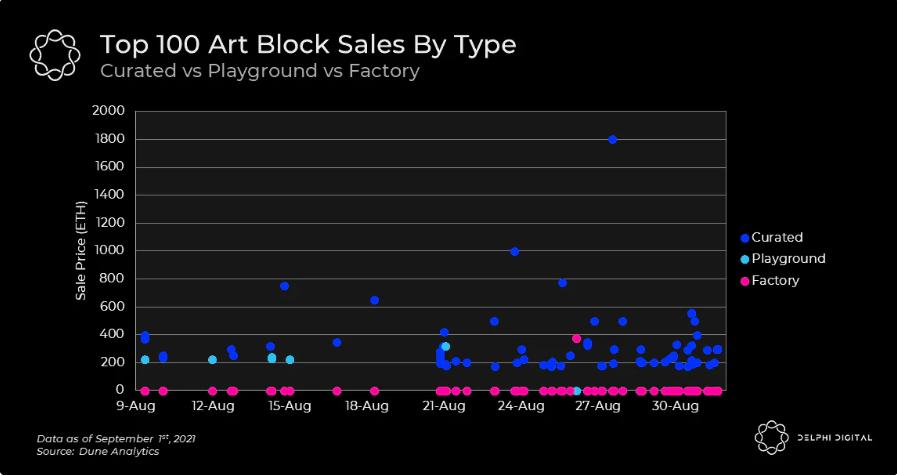
According to market data, curated Art Blocks projects are clearly the most sought-after type at the moment. With this in mind, let’s remove the Playground and Factory types from the chart above to focus on these high-value curated collections.

The recent sale of Ringers #879 for 1800 ETH marks the highest sale price for Art Blocks ever. This piece was purchased by Three Arrows Capital and added to their already impressive NFT collection. This sale of Ringers followed a week earlier when Fidenza #313 was purchased for 1000 ETH, also the highest sale price to date.
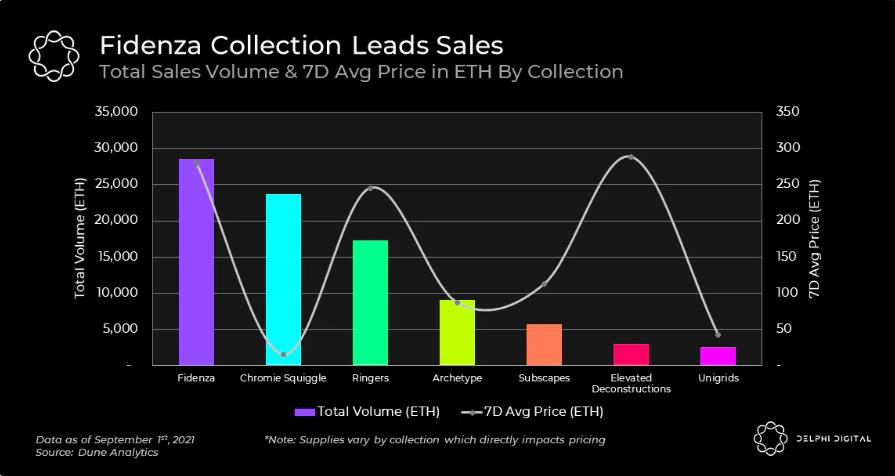
Fidenza, Chromie Squiggle, and Ringers all rank high in total sales volume. Considering that Fidenza was launched relatively recently (this summer compared to the first quarter of 2021), the fact that Fidenza leads in total sales volume is even more impressive.
Now, if we don’t give you a preview of what these collectibles actually look like, we would be irresponsibly discussing them, after all, this is an article about art. Let’s delve into these top collections and discuss what makes them highly attractive to both speculators and art connoisseurs.
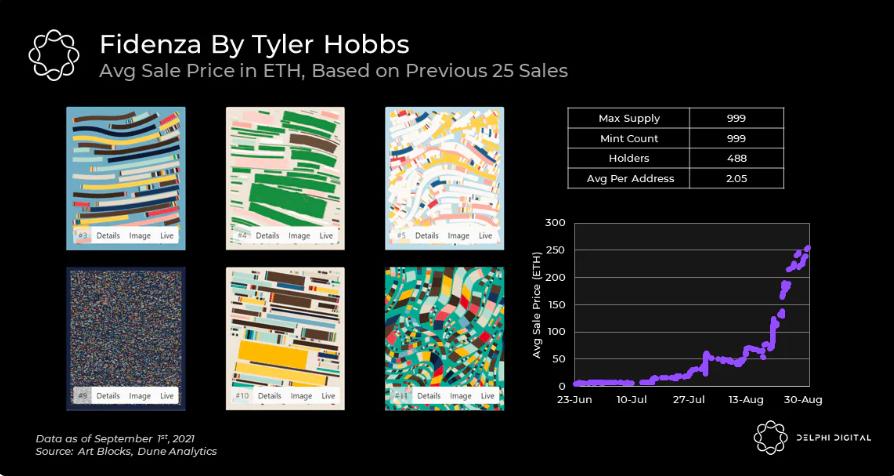
Tyler Hobbs' Fidenza is the first significant series, where each piece can be viewed as a highly regarded artwork, possessing unique aesthetic appeal and high complexity.
The project has even caught the attention of investors like Zhu Su from Three Arrows Capital, if you remember the earlier mention of the 1000 ETH purchase. Fidenza has seen a remarkable increase in a relatively short time, from an average minting price of 0.193 ETH to an average sale price exceeding 250 ETH over 25 days.
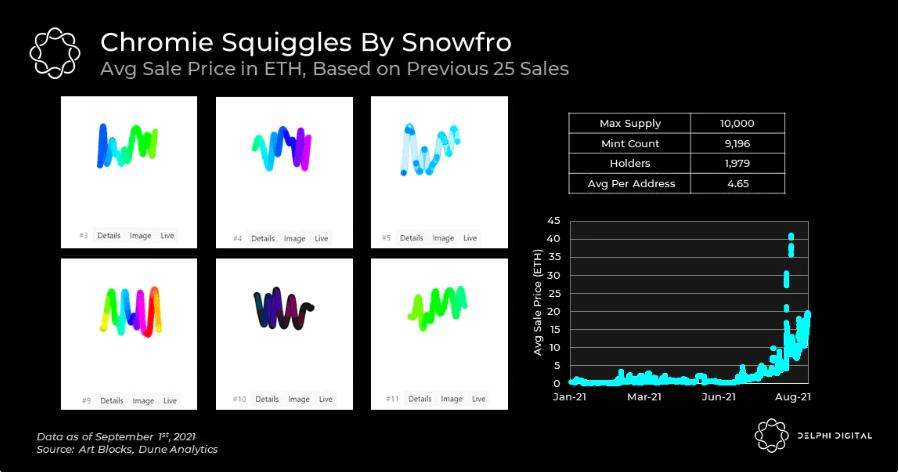
Chromie Squiggle, arguably the most well-known Art Blocks project, was created by Art Blocks founder Snowfro as the zero series. In Snowfro's words, Chromie Squiggle is "simple and easily recognizable, with each squiggle embodying the soul of the Art Blocks platform."
As an artist, developer, and tinkerer, consider my personal signature, "it embodies the concept of minimalist beauty." The average minting price for Chromie Squiggles is only 0.045 ETH, with the current 25-day average sale price around 20 ETH, recently peaking above 40 ETH. Importantly, Chromie Squiggles indeed have the largest supply among the focus series, with a maximum supply of 10,000, while others are below 1,000.
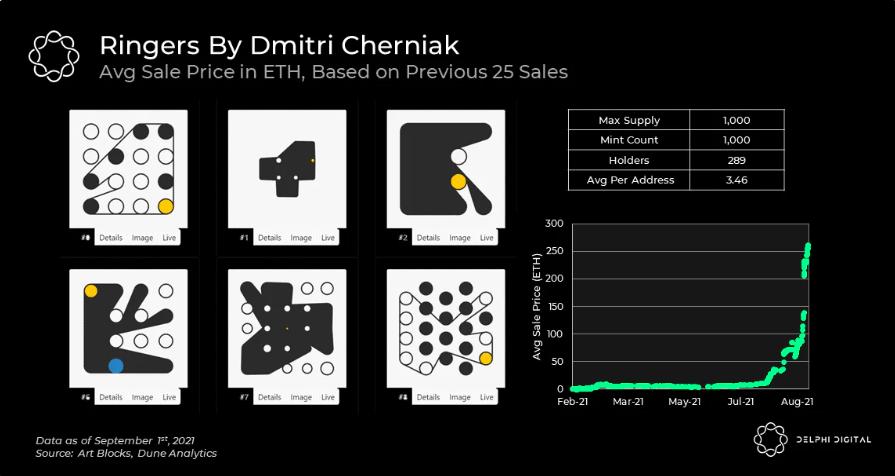
Dmitri describes "Ringers" as stemming from his curiosity about how a rope can be wrapped around various pegs in countless ways, with possible configurations exceeding the number of atoms in the universe, yet only 1000 exist; Ringers is the first project with so many variations. The simplicity and endless possibilities of Ringers have captivated the art world, rising from an average minting price of 0.16 ETH to a current 25-day average sale price exceeding 250 ETH.
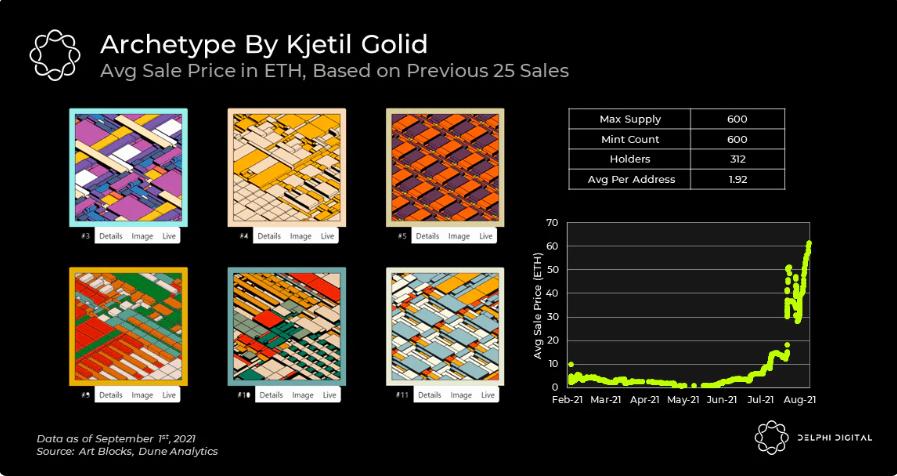
Kjetil Golid's "Archetype" combines the inherent randomness of native art with the use of structured repetitive patterns, achieving a balance between chaos and order. The average minting price for Archetype is 0.264 ETH, with the current 25-day average sale price slightly above 60 ETH.

The last series we focus on, Subscapes, answers the question—"What if 3D landscapes were art?" In terms of valuation, this project has climbed from an average minting price of 0.241 ETH to a current 25-day average sale price exceeding approximately 70 ETH.
2. Closing Thoughts
Although Art Blocks has solidified its position as the leading platform in the NFT art market, signs of overheating have begun to appear. Soaring valuations, people spending thousands of dollars on gas fees to mint a piece, and many items on OpenSea being sold at break-even or significant loss prices are all indicators worth noting.
Cryptocurrency speculators are accustomed to riding the price rollercoaster, but how these assets will perform in a severe downturn, considering the implications of non-fungibility on liquidity, remains to be seen. On the other hand, if a short-term correction occurs, long-term directional collectors who genuinely appreciate artworks may not be affected. After all, they did not intend to sell so quickly.
As the first generative art platform to gain significant attention in the cryptocurrency and art world, it can be said—Art Blocks will continue to exist. However, whether the Fidenza you mortgaged your house to buy will have lasting power is uncertain.
In the future, will people look back on these collections with reverence, as they do with Renaissance artworks? Or will they simply be one of the many on-chain artifacts forgotten by the collective metaverse mindset?










